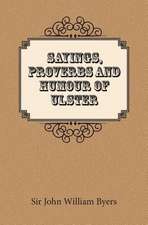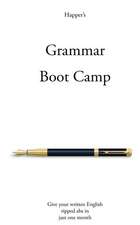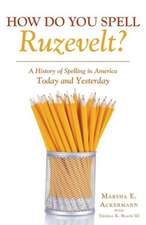A History of Psycholinguistics: The Pre-Chomskyan Era
Autor Willem Levelten Limba Engleză Paperback – 26 feb 2014
Preț: 385.65 lei
Preț vechi: 440.92 lei
-13% Nou
Puncte Express: 578
Preț estimativ în valută:
73.80€ • 76.24$ • 61.42£
73.80€ • 76.24$ • 61.42£
Carte tipărită la comandă
Livrare economică 15-21 martie
Preluare comenzi: 021 569.72.76
Specificații
ISBN-13: 9780198712213
ISBN-10: 0198712219
Pagini: 672
Ilustrații: black & white tables, figures
Dimensiuni: 174 x 245 x 34 mm
Greutate: 1.29 kg
Editura: Oxford University Press
Colecția OUP Oxford
Locul publicării:Oxford, United Kingdom
ISBN-10: 0198712219
Pagini: 672
Ilustrații: black & white tables, figures
Dimensiuni: 174 x 245 x 34 mm
Greutate: 1.29 kg
Editura: Oxford University Press
Colecția OUP Oxford
Locul publicării:Oxford, United Kingdom
Recenzii
What a gift Willem Levelt has bestowed upon language scientists! He has given us with a treasure chest of fascinating and invaluable scholarship that deepens our understanding of language and our attempts to understand it. Every language scientist should read this book.
Levelt could have left out the "A" from the title: this is the first time this history has been so comprehensively described.
Both psycholinguistic researchers and historians of psychology will benefit from the depth of Levelt's scholarship. Psycholinguists will discover a treasure trove of material on early studies of word recognition, child language, neurolinguistics, and other matters of contemporary concern The book covers ideas and controversies, influential as well as forgotten figures, and personal stories of success and tragedy. It is a gift for anyone interested in the science of language and its history, one to which readers will return again and again in the years to come.
No one else could have written the history of psycholinguistics. For Levelt has gone on a deep archaeological exploration of what he terms the prehistory of his field, bringing to life dozens and dozens of strange and wonderful thinkers and researchers, back to the true beginnings of the field about 250 years ago. This is a gripping book... It is a book to live with, to wander through, to return to again and again. These remarkable fifteen chapters guarantee, indeed, that language remains.
Levelt's book is a beautiful illustration of just how rich research in scientific psychology was in the second half of the 19th century and how much has been forgotten... It should also be read by everyone interested in language research. They will not only discover the true origins of their pet theories, but will also have several evenings of pure delight while reading the book.
A comprehensive and thorough history of psycholinguistics in the pre-Chromskyan period Anyone with an interest in language will enjoy reading this book.
This lengthy 653-page book is impressive in its scope and thoroughness... Levelt is a fine researcher of original texts. He is extremely methodical in clearly citing references to original documents and is careful to thanks colleagues for pointing out sources to him. Levelt provides a large number of translated citations (except when they are "too obnoxious to translate", p. 122) as well as original texts for every citation, included as footnotes. This allows the reader to form her own opinion about the original logic or theory of the cited author (as long as they are able to read the language). This is also a practical time-saver, as many of the cited texts are somewhat difficult to access.
Many interesting discoveries and surprises await the reader with an interest in research, or history, or the history of research.
This is a book that psycholinguists will want on their shelves or in their Kindles. It is an invaluable resource, both for those who want to look up the answer to a few historical questions and for those wanting a complete historical perspective on this facinating discipline.
Anyone who has two pairs of trousers should sell one of them and buy this book.
Levelt could have left out the "A" from the title: this is the first time this history has been so comprehensively described.
Both psycholinguistic researchers and historians of psychology will benefit from the depth of Levelt's scholarship. Psycholinguists will discover a treasure trove of material on early studies of word recognition, child language, neurolinguistics, and other matters of contemporary concern The book covers ideas and controversies, influential as well as forgotten figures, and personal stories of success and tragedy. It is a gift for anyone interested in the science of language and its history, one to which readers will return again and again in the years to come.
No one else could have written the history of psycholinguistics. For Levelt has gone on a deep archaeological exploration of what he terms the prehistory of his field, bringing to life dozens and dozens of strange and wonderful thinkers and researchers, back to the true beginnings of the field about 250 years ago. This is a gripping book... It is a book to live with, to wander through, to return to again and again. These remarkable fifteen chapters guarantee, indeed, that language remains.
Levelt's book is a beautiful illustration of just how rich research in scientific psychology was in the second half of the 19th century and how much has been forgotten... It should also be read by everyone interested in language research. They will not only discover the true origins of their pet theories, but will also have several evenings of pure delight while reading the book.
A comprehensive and thorough history of psycholinguistics in the pre-Chromskyan period Anyone with an interest in language will enjoy reading this book.
This lengthy 653-page book is impressive in its scope and thoroughness... Levelt is a fine researcher of original texts. He is extremely methodical in clearly citing references to original documents and is careful to thanks colleagues for pointing out sources to him. Levelt provides a large number of translated citations (except when they are "too obnoxious to translate", p. 122) as well as original texts for every citation, included as footnotes. This allows the reader to form her own opinion about the original logic or theory of the cited author (as long as they are able to read the language). This is also a practical time-saver, as many of the cited texts are somewhat difficult to access.
Many interesting discoveries and surprises await the reader with an interest in research, or history, or the history of research.
This is a book that psycholinguists will want on their shelves or in their Kindles. It is an invaluable resource, both for those who want to look up the answer to a few historical questions and for those wanting a complete historical perspective on this facinating discipline.
Anyone who has two pairs of trousers should sell one of them and buy this book.
Notă biografică
Willem Levelt is director emeritus of the Max Planck Institute for Psycholinguistics in Nijmegen, The Netherlands, which he founded in 1980. He is also emeritus honorary professor of psycholinguistics at Nijmegen University. He has a PhD in psychology from Leiden University (1965), was a postdoctoral research fellow at Harvard University, a visiting professor at the University of Illinois, full professor of psychology at Groningen University, member at The Institute for Advanced Study in Princeton (1971-1972), professor of experimental psychology at Nijmegen University and, since 1980, scientific member of the Max Planck Society. He has published widely in psychophysics, mathematical psychology and psycholinguistics. His books include On binocular rivalry (1965), Formal grammars in linguistics and psycholinguistics (3 Vols, 1974, republished in 2008) and Speaking: From intention to articulation (1989).
















